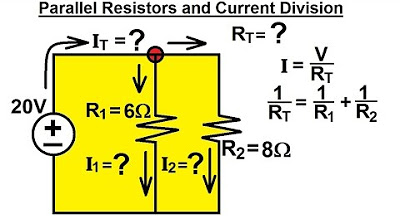Electrical Engineering: Basic Laws (16 of 31) NOTE ERROR! Finding the Equivalent Resistor Ex. 1
Summary
TLDRIn this video, the presenter demonstrates how to find the equivalent resistance in a circuit by using two fundamental rules: resistors in series share the same node, while resistors in parallel share pairs of nodes. The example involves combining resistors step by step, simplifying a complex circuit into a single equivalent resistor. The video walks through adding series resistors and calculating parallel resistors using their product and sum, ultimately finding the total resistance. The process shows how to methodically simplify circuits, making it easier to understand their overall resistance.
Takeaways
- ⚙️ The video demonstrates how to calculate the equivalent resistance in circuits using series and parallel resistor combinations.
- 📏 Two resistors are in series if they share an exclusive common node.
- 🔗 Two resistors are in parallel if they each share a pair of common nodes.
- 🔧 The total resistance of resistors in series is the sum of their individual resistances.
- ⚖️ For two resistors in parallel, the total resistance is the product of the resistances divided by the sum of the resistances.
- 🔍 Example 1: The 4-ohm and 8-ohm resistors are in series, resulting in an equivalent resistance of 12 ohms.
- 🧮 Example 2: Two 10-ohm resistors in parallel result in an equivalent resistance of 5 ohms.
- 🔁 The circuit is redrawn after simplifying, replacing multiple resistors with their equivalent single resistors.
- 📝 The final equivalent resistance of the entire circuit is calculated to be 9 ohms.
- 💡 Equivalent resistance and total resistance are often used interchangeably in circuit problems.
Q & A
What are the two rules for determining if resistors are in series or parallel?
-Two resistors are in series if they share the same node exclusively, and they are in parallel if they each share a pair of nodes.
How do you calculate the total resistance for resistors in series?
-The total resistance for resistors in series is the sum of the individual resistances.
What is the formula for calculating the total resistance when two resistors are in parallel?
-For two resistors in parallel, the total resistance is calculated as the product of the resistances divided by the sum of the resistances, i.e., \( \frac{R_1 \times R_2}{R_1 + R_2} \).
What is the equivalent resistance of a 4-ohm and an 8-ohm resistor in series?
-The equivalent resistance of a 4-ohm and an 8-ohm resistor in series is 12 ohms.
How do you simplify a circuit with resistors in parallel?
-You replace the parallel resistors with a single resistor whose value is calculated using the formula for parallel resistance.
What is the equivalent resistance of two 10-ohm resistors in parallel?
-The equivalent resistance of two 10-ohm resistors in parallel is 5 ohms.
How do you redraw a circuit after combining resistors?
-After combining resistors, you replace them with their equivalent resistance value in the circuit diagram.
What is the equivalent resistance when a 7-ohm and a 10-ohm resistor are in series?
-The equivalent resistance of a 7-ohm and a 10-ohm resistor in series is 17 ohms.
How do you calculate the total resistance when a 17-ohm and a 12-ohm resistor are in parallel?
-The total resistance when a 17-ohm and a 12-ohm resistor are in parallel is approximately 7 ohms, calculated as \( \frac{17 \times 12}{17 + 12} \approx 7 \) ohms.
What is the final equivalent resistance of the circuit described in the script?
-The final equivalent resistance of the circuit is 9 ohms.
What is the difference between finding the equivalent resistance and the total resistance of a circuit?
-The terms 'equivalent resistance' and 'total resistance' are used interchangeably; they both refer to the process of simplifying a circuit to a single resistance value.
Outlines

This section is available to paid users only. Please upgrade to access this part.
Upgrade NowMindmap

This section is available to paid users only. Please upgrade to access this part.
Upgrade NowKeywords

This section is available to paid users only. Please upgrade to access this part.
Upgrade NowHighlights

This section is available to paid users only. Please upgrade to access this part.
Upgrade NowTranscripts

This section is available to paid users only. Please upgrade to access this part.
Upgrade NowBrowse More Related Video

Electrical Engineering: Basic Laws (17 of 31) Finding the Equivalent Resistor Ex. 2

Electrical Engineering: Basic Laws (18 of 31) Finding the Equivalent Resistor Ex. 3

Equivalent Resistance of a Complex Circuit with Series and Parallel Resistors

Electrical Engineering: Basic Laws (7 of 31) Differences Between Series and Parallel Current

Electrical Engineering: Basic Laws (14 of 31) Parallel Resistors and Current Division

What are Branches, Nodes, and Loops with Series and Parallel Components? | Basic Electronics
5.0 / 5 (0 votes)